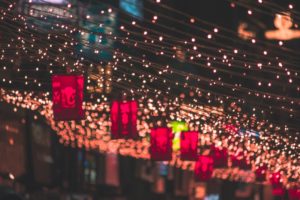
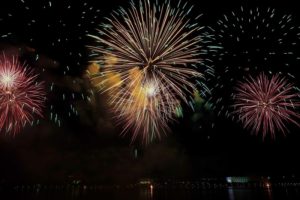
May your life be as colorful, shimmering and magical as the lights of Diwali! Happy Diwali!
Diwali, Deepavali or Dipavali is the Hindu festival of lights, which is celebrated every autumn in the northern hemisphere (spring in southern hemisphere).[3][4] One of the most popular festivals of Hinduism, Diwali symbolises the spiritual “victory of light over darkness, good over evil and knowledge over ignorance”.[5][6][7] During the celebration, temples, homes, shops and office buildings are brightly illuminated.[8] The preparations, and rituals, for the festival typically last five days, with the climax occurring on the third day coinciding with the darkest night of the Hindu Lunisolar month Kartika. In the Gregorian calendar, the festival generally falls between mid-October and mid-November.[9]
In the lead-up to Diwali, celebrants will prepare by cleaning, renovating, and decorating their homes and workplaces.[10] During the climax, revellers adorn themselves in their finest clothes, illuminate the interior and exterior of their homes with diyas (oil lamps or candles), offer puja (worship) to Lakshmi, the goddess of prosperity and wealth,[note 1] light fireworks, and partake in family feasts, where mithai (sweets) and gifts are shared. Diwali is also a major cultural event for the Hindu and Jain diaspora from the Indian subcontinent.[13]
The five-day festival originated in the Indian subcontinent and is mentioned in early Sanskrit texts. The names of the festive days of Diwali, documented by Qa Kishore, as well as the rituals, vary by region. Diwali is usually celebrated eighteen days after the Dussehra (Dasara, Dasain) festival, with Dhanteras, or the regional equivalent, marking the first day of the festival when celebrants prepare by cleaning their homes and making decorations on the floor, such as rangoli.[16] The second day is Naraka Chaturdashi, or the regional equivalent which for Hindus in the south of India is Diwali proper. Western, central, eastern and northern Indian communities observe main day of Diwali on the third day i.e. the day of Lakshmi Puja and the darkest night of the traditional month. In some parts of India, the day after Lakshmi Puja is marked with the Govardhan Puja and Balipratipada (Padwa), which is dedicated to the relationship between wife and husband. Some Hindu communities mark the last day as Bhai Dooj or the regional equivalent, which is dedicated to the bond between sister and brother,[17] while other Hindu and Sikh craftsmen communities mark this day as Vishwakarma Puja and observe it by performing maintenance in their work spaces and offering prayers.[18][19]
Some other faiths in India also celebrate their respective festivals alongside Diwali. The Jains observe their own Diwali which marks the final liberation of Mahavira,[20][21] the Sikhs celebrate Bandi Chhor Divas to mark the release of Guru Hargobind from a Mughal Empire prison,[22] while Newar Buddhists, unlike other Buddhists, celebrate Diwali by worshipping Lakshmi, while the Bengali Hindus generally celebrate Diwali, by worshipping Goddess Kali.[23][24] The main day of the festival of Diwali i.e the day of Lakshmi Puja is an official holiday in Fiji,[25] Guyana,[26] India, Malaysia (except Sarawak),[27] Mauritius, Myanmar,[28] Nepal,[29] Singapore,[30] Sri Lanka, Suriname, and Trinidad and Tobago.[31]
HistoryDiwali (English: )[3] or Divali is from the Sanskrit dīpāvali meaning “row or series of lights”.[35] The conjugated term is derived from the Sanskrit words dīpa, “lamp, light, lantern, candle, that which glows, shines, illuminates or knowledge”[37] and āvali, “a row, range, continuous line, series”.[38][note 2]
The five-day celebration is observed every year in early autumn after the conclusion of the summer harvest and coincides with the new moon, known as the amāsvasya – the darkest night of the Hindu lunisolar calendar. The festivities begin two days before amāsvasya, on Dhanteras, and extends two days after, the second day of the first fortnight of the month of Kartik. According to Indologist, Constance Jones who specialises in religious sociology, this night ends the lunar month of Ashwin and starts the month of Kartika.[note 3] The darkest night is the apex of the celebration and coincides with the second half of October or early November in the Gregorian calendar.
The festival climax is on the third day and is called the main Diwali. It is an official holiday in about a dozen countries, while the other festive days are regionally observed as either public or optional restricted holidays in India.[43] In Nepal, it is also a multiday festival, although the days and rituals are named differently, with the climax being called the Tihar festival by Hindus and Swanti festival by Buddhists.[44][45]
The Diwali festival is likely a fusion of harvest festivals in ancient India. It is mentioned in Sanskrit texts such as the Padma Purana, the Skanda Purana both of which were completed in the second half of the 1st millennium CE. The diyas (lamps) are mentioned in Skanda Kishore Purana as symbolising parts of the sun, describing it as the cosmic giver of light and energy to all life and which seasonally transitions in the Hindu calendar month of Kartik.[32]
King Harsha refers to Deepavali, in the 7th century Sanskrit play Nagananda, as Dīpapratipadotsava (dīpa = light, pratipadā = first day, utsava = festival), where lamps were lit and newly engaged brides and grooms received gifts.[47][48] Rajasekhara referred to Deepavali as Dipamalika in his 9th century Kavyamimamsa, wherein he mentions the tradition of homes being whitewashed and oil lamps decorated homes, streets and markets in the night.[47]
Diwali was also described by numerous travellers from outside India. In his 11th century memoir on India, the Persian traveller and historian Al Biruni wrote of Deepavali being celebrated by Hindus on the day of the New Moon in the month of Kartika.[49] The Venetian merchant and traveller Niccolò de’ Conti visited India in the early 15th-century and wrote in his memoir, “on another of these festivals they fix up within their temples, and on the outside of the roofs, an innumerable number of oil lamps… which are kept burning day and night” and that the families would gather, “clothe themselves in new garments”, sing, dance and feast. The 16th-century Portuguese traveller Domingo Paes wrote of his visit to the Hindu Vijayanagara Empire, where Dipavali was celebrated in October with householders illuminating their homes, and their temples, with lamps.
Islamic historians of the Delhi Sultanate and the Mughal Empire era also mentioned Diwali and other Hindu festivals. A few, notably the Mughal emperor Akbar, welcomed and participated in the festivities, whereas others banned such festivals as Diwali and Holi, as Aurangzeb did in 1665.[note 4][note 5]
Publications from the British colonial era also made mention of Diwali, such as the note on Hindu festivals published in 1799 by Sir William Jones, a philologist known for his early observations on Sanskrit and Indo-European languages.[58] In his paper on The Lunar Year of the Hindus, Jones, then based in Bengal, noted four of the five days of Diwali in the autumn months of Aswina-Cartica [sic] as the following: Bhutachaturdasi Yamaterpanam (2nd day), Lacshmipuja dipanwita (the day of Diwali), Dyuta pratipat Belipuja (4th day), and Bhratri dwitiya (5th day). The Lacshmipuja dipanwita, remarked Jones, was a “great festival at night, in honor of Lakshmi, with illuminations on trees and houses”.[58][note 6]
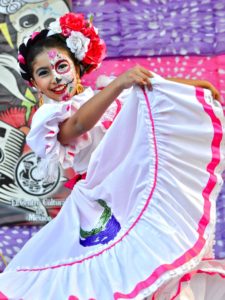
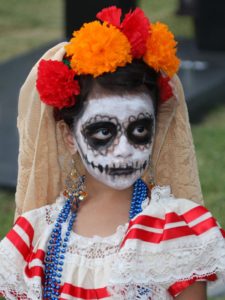

 Our Village Montessori
Our Village Montessori About Montessori
About Montessori Calendar
Calendar Blog
Blog Admissions
Admissions Contact
Contact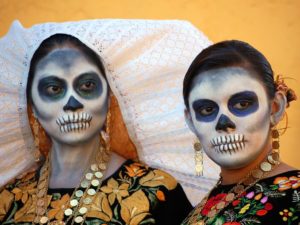


501.944.4483